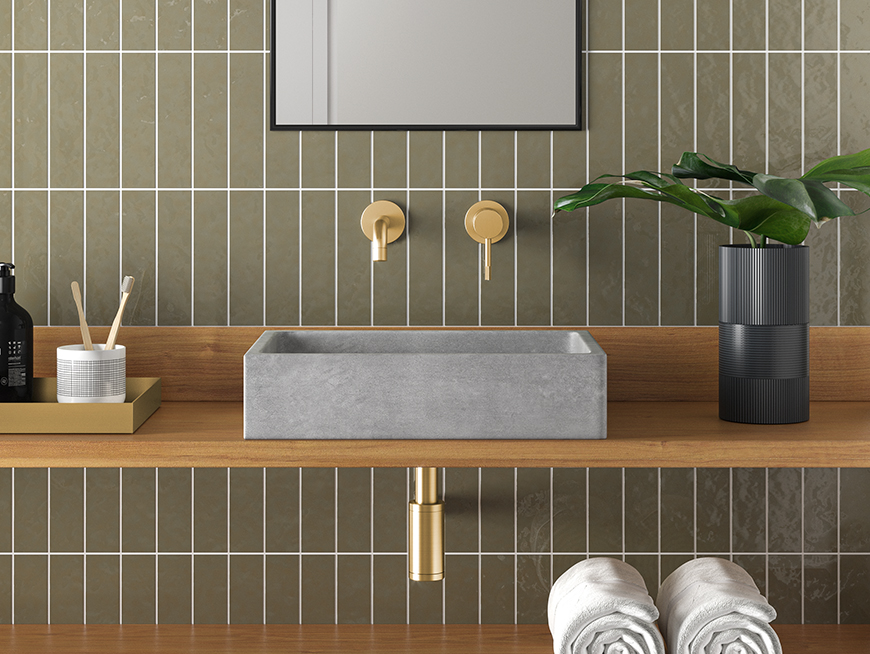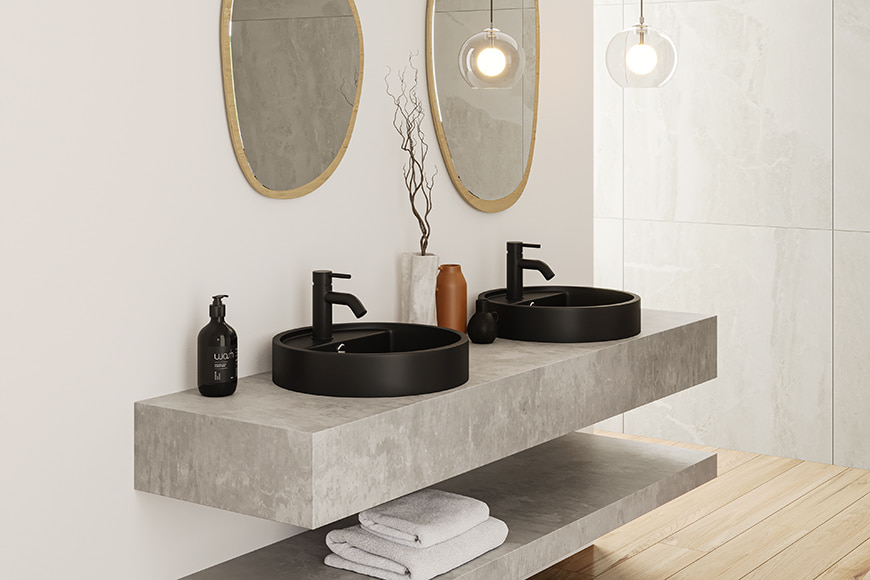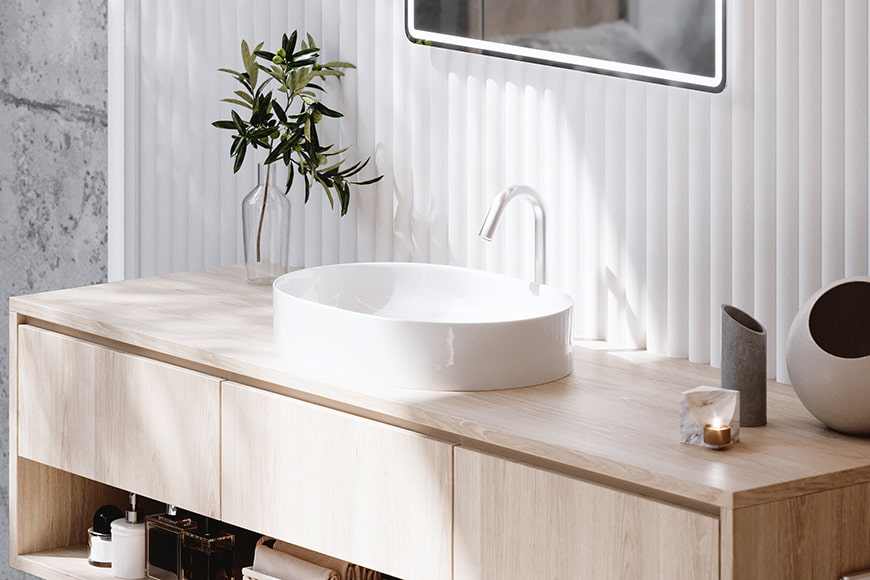Understanding the different types of Bathroom Basins
Monday 02 October 2023

The bathroom basin, while undeniably functional, can also serve as a major design element in your bathroom.
Offering a blend of style and purpose, bathroom basins come in a variety of types, including inset, undermount, vessel, and wall-mounted.
Each type delivers a unique aesthetic and suits different needs and space constraints.
In this blog post, we will delve into these four main types of bathroom basins, providing a comprehensive understanding that can guide your selection process.
What type of bathroom basin is available?
Overview of the Different Types of Bathroom Basins
To start, let's briefly introduce these four different types of basins:
- Inset basins are easy to install and suit a wide range of bathroom styles due to their versatility. They are designed to drop into a hole in your countertop, with the basin rim sitting on top.
- Undermount basins are installed beneath the countertop, creating a seamless look and making it easy to wipe water and debris from the countertop into the basin.
- Vessel basins are bowl-shaped units that sit on top of your countertop. These basins make a bold statement and can serve as a focal point in your bathroom.
- Wall-mounted basins are attached directly to the wall, freeing up valuable floor space. These are great for smaller bathrooms or powder rooms.
Each of these basin types has its own unique advantages and potential drawbacks, which you can learn more about below.
Inset Basins - Pros and Cons
Inset basins, also known as self-rimming or top-mount basins, are among the most common types of bathroom basins due to their ease of installation and broad compatibility with various countertop materials.
 |  |
Pros of Inset Basins
Inset basins are particularly popular due to their simple installation process. They don't require internal support within the countertop, as the rim of the basin supports its weight. This feature allows for greater flexibility when choosing a countertop material.
Another advantage of inset basins is the variety of designs available. They come in an array of styles, sizes, and materials, making it easy to find one that matches your bathroom decor.
Cons of Inset Basins
However, inset basins have their downsides. The pronounced lip of the basin that rests on the countertop can make cleaning more challenging. Water and debris can collect around this area, requiring extra attention during cleaning.
Also, inset basins may not provide as sleek or seamless an appearance as undermount or vessel basins. The visible edge of the basin may interrupt the flow of the countertop design.
Undermount Basins - Pros and Cons
Undermount basins, as their name suggests, are installed directly under the countertop, providing a seamless look and sophisticated aesthetic appeal.
 |  |
Pros of Undermount Basins
One of the chief advantages of undermount basins is their sleek, streamlined design. With their edges hidden beneath the countertop, these basins offer a clean, minimalist look that can elevate the overall aesthetic of any bathroom.
In addition to their appealing design, undermount basins are also particularly practical when it comes to cleaning. Without a lip or rim on the countertop, you can easily wipe debris directly into the basin, making the cleaning process more efficient.
Cons of Undermount Basins
Despite their aesthetic appeal and practical benefits, undermount basins also have certain drawbacks. The installation process, for instance, can be more complex and time-consuming than that of inset basins, and they typically require strong, sturdy countertop materials to support their weight.
The cost of undermount basins, along with the potential need for professional installation, can also be higher than that of other basin types. Thus, while undermount basins can enhance the style and functionality of a bathroom, they may not be the best choice for all budgets or design preferences.
Vessel Basins - Pros and Cons
Vessel basins, also known as basin or bowl basins, are a uniquely modern addition to any bathroom. With their design featuring bowls that sit atop the countertop, they serve as an artistic centrepiece while also serving a functional purpose.
 |  |
Pros of Vessel Basins
One of the primary benefits of vessel basins is their high-end, contemporary appeal. With a variety of shapes, sizes, and materials available, they can dramatically enhance the design of any bathroom.
Vessel basins also offer the advantage of versatility in terms of installation. Since they sit on top of the countertop, they can be positioned at a comfortable height, potentially reducing strain and improving overall usability.
Cons of Vessel Basins
On the downside, vessel basins require careful planning and consideration. The heightened design means that they can be more prone to splashing, and their exposed sides may require frequent cleaning to maintain their pristine appearance.
Additionally, while the installation may be flexible, it can also be complex, requiring precise drilling for the drain and faucet. The cost of vessel basins, particularly high-end designs, may also be a potential drawback for those on a tighter budget. Therefore, while vessel basins can be a striking addition to a bathroom, they require careful consideration and planning.
Wall-mounted Basins - Pros and Cons
Wall-mounted basins, as the name suggests, are affixed directly to the wall, eliminating the need for a vanity or pedestal beneath. This feature creates a minimalist, space-saving design that can be a fantastic solution for smaller bathrooms.
 |  |
Pros of Wall-mounted Basins
The most obvious advantage of wall-mounted basins is the space-saving design. This type of basin is ideal for compact bathrooms where every inch of space is precious. The lack of a vanity or countertop also makes the floor area appear larger, contributing to an overall impression of spaciousness.
Wall-mounted basins also offer an element of flexibility, as they can be installed at virtually any height. This makes them a practical choice for households with individuals of different heights or for those with specific accessibility requirements.
Cons of Wall-mounted Basins
However, wall-mounted basins do come with their challenges. For instance, they do not provide any storage space beneath, a feature that can be crucial in bathrooms where storage is limited.
The installation process may also require careful planning and execution. Since the basin is attached directly to the wall, it is important that the wall is structurally sound and capable of bearing the weight of the basin. Otherwise, reinforcement may be necessary, adding to the overall cost and complexity of the installation. Additionally, the plumbing is exposed with this style of basin, which may not be aesthetically pleasing to all. Lastly, due to the lack of a vanity or pedestal, wall-mounted basins may not offer the same level of stability as other basin types, which could be a concern for households with children.
Tips for Choosing a Bathroom Basin
When it comes to selecting a bathroom basin, there are several key factors to consider. Primarily, the size and layout of your bathroom will significantly influence the type of basin that is most suitable. For smaller bathrooms, a compact, space-saving design like a wall-mounted or pedestal basin may be ideal. For larger bathrooms, you may have the space to opt for a vanity unit with an integrated basin, offering additional storage space.
Material is another important consideration. Common materials for bathroom basins include porcelain, which is known for its durability and timeless appeal, and glass, which can add a touch of modernity to your bathroom. Keep in mind that the material not only affects the appearance of the basin but also its maintenance needs and longevity.
Moreover, consider the practicality of installation. Certain types of basins, like wall-mounted basins, may require more complex installation processes or additional structural reinforcement.
Lastly, the style and aesthetic of your bathroom will also play a role. From traditional pedestal basins to sleek, modern vessel basins, there are options to suit every taste. Choose a basin that complements the existing decor of your bathroom or sets the tone for a new design scheme.
Remember, while the appearance of your basin is important, functionality and practicality should not be overlooked. Your chosen basin should serve its purpose equally as well as it adds to the aesthetic appeal of your bathroom.
Benefits of Installing a New Bathroom Basin
Installing a new bathroom basin can bring several benefits to your home. Firstly, it can significantly enhance the aesthetic appeal of your bathroom. A well-chosen basin can act as a focal point, bringing a sense of style and sophistication.
Secondly, a new basin can improve functionality. If your current basin is too small, or lacks storage space, upgrading to a new model can provide increased practicality. For instance, a vanity unit with an integrated basin can provide ample space for toiletries and other bathroom essentials.
Thirdly, if your existing basin is showing signs of wear and tear, a new basin can contribute to the overall durability and maintenance of the bathroom. Modern basins are often constructed from robust materials, designed to withstand heavy usage and last for years.
Lastly, installing a new basin can potentially increase your property's value. A well-designed, modern bathroom is a big selling point and can add significant value to your home.
In conclusion, while installing a new bathroom basin requires investment, the potential aesthetic, functional, and financial benefits make it a worthwhile consideration.
Important Considerations When Shopping for a New Basin
When shopping for a new basin, there are several crucial factors to consider to ensure that you make the most suitable choice for your needs and preferences.
Firstly, think about the dimensions of your bathroom. The basin size should be proportional to the room size. A large basin in a small bathroom can make the space feel cramped, while a small basin in a large bathroom may look out of place.
Next, consider the basin's style and design. It should complement the overall aesthetics of your bathroom. Whether you prefer a traditional or a modern design, there are a plethora of options available in the market that can cater to your taste.
Material choice is another significant consideration. From ceramic and glass to stone and stainless steel, the material can determine the basin’s durability, ease of maintenance, and visual appeal. For example, a ceramic basin offers a classic look and is easy to clean, while a glass basin can add a contemporary touch.
Lastly, consider the installation type of the basin. Whether it's a pedestal basin, a wall-mounted basin, or a countertop basin, the installation type should align with your bathroom's layout and your storage needs.
Remember, the ideal basin is not just aesthetically pleasing but also functional and durable. Therefore, considering these factors can help you make an informed decision and ensure that your new basin adds value to your bathroom.
Summary
In conclusion, when it comes to selecting the right bathroom basin for your home, it's important to be aware of the different types available and to consider their pros and cons.
There are several factors to bear in mind such as space constraints, ease of installation and personal style preference. Whether you opt for a inset, undermount, vessel, or wall-mounted basin, take time to explore all of your options carefully before making a decision that best suits your needs.
Now that you know the four main types of bathroom basins and their associated benefits and drawbacks, why not check out the huge range of bathroom basins at Robertson Bathware? We have an extensive selection of bathroom basins at competitive prices and we're confident we have something perfect for your specific requirements.